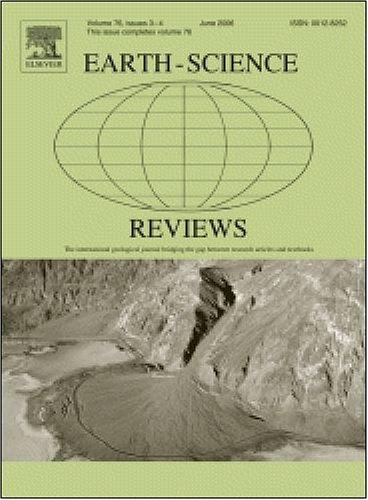Research progress and current application of weak turbulence and turbulence intermittency in stable boundary layers
IF 10.8
1区 地球科学
Q1 GEOSCIENCES, MULTIDISCIPLINARY
引用次数: 0
Abstract
Research on the stable boundary layer is not only a scientific challenge but is also the foundation of studies on the atmospheric environment, weather, and climate change, with significant practical value in social and economic development. Starting from the mutual transitions between weakly and strongly stable boundary layer states, we review the research progress and application of weak turbulent motions and turbulence intermittency. Turbulent intermittency can be driven by internal (the feedback interaction of wind shear and stability) and external factors (sub-mesoscale motions). We clarified the interaction mechanism between the internal and external factors of turbulent intermittency and elucidated how the interaction affects the evolution of stable boundary layer. Given the widespread existence and importance of sub-mesoscale motion, by separating and quantitatively characterizing sub-mesoscale and turbulent motions from the complex flow fields of stable boundary layers, turbulence intermittency can be identified and quantitatively characterized. Accordingly, the typical characteristics of alternating quiescent and bursting periods of turbulence intermittency events can be determined. Notably, during weak turbulence and quiescent periods of turbulence intermittency, the turbulent transport of matter and energy can be affected by sub-mesoscale motions, has been overestimated easily, relevant corrections are necessary. Eliminating the effects of sub-mesoscale motions can improve the similarity relationships of the stable boundary layers. Moreover, non-stationary turbulent transport during bursting periods of turbulence intermittency events will change the general understanding of classical problems. For example, the surface energy closure rate during the bursting periods can even be very close to totally closure. Turbulence intermittency has wide applications. In this study, turbulence intermittency is combined with haze pollution research to propose the concept of the turbulence barrier effect and investigate the physical mechanisms through which turbulence barriers can be strengthened or broken. The turbulence barrier effect significantly affects turbulent transport of matter, such as carbon dioxide and water vapor; thus, it is vital in practical issues, such as early warning for dust storms and dense fog events. However, three key challenges still require further investigation: physical mechanisms of state transitions and mechanisms of vertical structure evolution in stable boundary layers; physical origins, spatial and temporal evolution patterns, and parameterization of turbulence intermittency; and improvement of the similarity theory of stable boundary layers. Finally, we discussed future research directions on weak turbulence and turbulence intermittency in stable boundary layers, and explored the potential applications of observational facts, theoretical breakthroughs, and simulation advances in stable boundary layers to improve air pollution forecasts, extreme weather warning, and climate change projections.
稳定边界层弱湍流和湍流间歇性的研究进展及应用现状
稳定边界层的研究不仅是一项科学挑战,而且是大气环境、天气和气候变化研究的基础,在社会和经济发展中具有重要的实用价值。从弱稳定边界层和强稳定边界层状态的相互转换出发,综述了弱湍流运动和湍流间歇性的研究进展及其应用。湍流间歇性可以由内部因素(风切变和稳定性的反馈相互作用)和外部因素(亚中尺度运动)驱动。阐明了湍流间歇性的内外因素相互作用的机理,阐明了这种相互作用如何影响稳定边界层的演化。鉴于亚中尺度运动的广泛存在和重要性,通过将亚中尺度和湍流运动从稳定边界层的复杂流场中分离出来并进行定量表征,可以对湍流间歇性进行识别和定量表征。据此,可以确定湍流间歇事件的静止和爆发交替周期的典型特征。值得注意的是,在弱湍流和湍流间歇的静息期,物质和能量的湍流输运会受到亚中尺度运动的影响,容易被高估,有必要进行相应的修正。消除亚中尺度运动的影响可以改善稳定边界层的相似关系。此外,湍流间歇事件爆发期间的非平稳湍流输运将改变对经典问题的一般理解。例如,爆破期间的表面能闭合率甚至可以非常接近于完全闭合。湍流间歇性具有广泛的应用。本研究将湍流间歇性与雾霾污染研究相结合,提出了湍流屏障效应的概念,并探讨了湍流屏障增强或破坏的物理机制。湍流屏障效应显著地影响了二氧化碳和水蒸气等物质的湍流输运;因此,在实际问题中,如沙尘暴和浓雾事件的早期预警,它是至关重要的。然而,三个关键挑战仍需要进一步研究:稳定边界层中状态转变的物理机制和垂直结构演化机制;湍流间歇性的物理成因、时空演化模式及参数化以及对稳定边界层相似理论的改进。最后,讨论了稳定边界层弱湍流和湍流间歇性的未来研究方向,并探讨了稳定边界层观测事实、理论突破和模拟进展在改善大气污染预报、极端天气预警和气候变化预测方面的潜在应用。
本文章由计算机程序翻译,如有差异,请以英文原文为准。
求助全文
约1分钟内获得全文
求助全文
来源期刊

Earth-Science Reviews
地学-地球科学综合
CiteScore
21.70
自引率
5.80%
发文量
294
审稿时长
15.1 weeks
期刊介绍:
Covering a much wider field than the usual specialist journals, Earth Science Reviews publishes review articles dealing with all aspects of Earth Sciences, and is an important vehicle for allowing readers to see their particular interest related to the Earth Sciences as a whole.
 求助内容:
求助内容: 应助结果提醒方式:
应助结果提醒方式:


